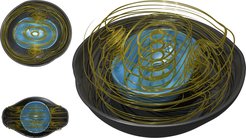Through the numerical looking glass
3D visualisations of numerical relativity simulations improve understanding of neutron star mergers
The multi-messenger observation of gravitational waves from the neutron-star merger GW170817 and its electromagnetic counterparts is an excellent opportunity to test our understanding of the fundamental forces of nature. However, predicting the outcome of a neutron-star merger is far from trivial. Numerical computer simulations of such events have greatly contributed to this task. Nevertheless, calculating something with the help of large-scale computer simulations and understanding the results are two different things. This is why the analysis and visualization of raw simulation data become ever more important. In a recent work, researchers from the AEI Hannover have performed simulations of merging neutron-star binaries and studied the resulting data in depth. They developed novel visualizations and analysis techniques that provide a more intuitive understanding of short-lived, massive neutron stars that are believed to be produced in events like GW170817. Among other things, the study revealed that the internal flow pattern within a newly merged neutron star can be more complicated than often assumed. The publication also sheds some light on the important question of how and why such massive stars collapse. Raytracing software was used to improve typical three-dimensional visualizations by providing additional visual clues. As an additional benefit, the same methods were employed to create a public outreach video.
Visualisierung einer Neutronensternverschmelzung
Paper abstract
The first multimessenger observation attributed to a merging neutron star binary provided an enormous amount of observational data. Unlocking the full potential of this data requires a better understanding of the merger process and the early postmerger phase, which are crucial for the later evolution that eventually leads to observable counterparts. In this work, we perform standard hydrodynamical numerical simulations of a system compatible with GW170817. We focus on a single equation of state and two mass ratios, while neglecting magnetic fields and neutrino radiation. We then apply newly developed postprocessing and visualization techniques to the results obtained for this basic setting. The focus lies on understanding the three-dimensional structure of the remnant, most notably the fluid flow pattern, and its evolution until collapse. We investigate the evolution of mass and angular momentum distribution up to collapse, as well as the differential rotation along and perpendicular to the equatorial plane. For the cases that we studied, the remnant cannot be adequately modeled as a differentially rotating axisymetric neutron star. Further, the dominant aspect leading to collapse is the gravitational wave radiation and not internal redistribution of angular momentum. We relate features of the gravitational wave signal to the evolution of the merger remnant and make the waveforms publicly available. Finally, we find that the three-dimensional vorticity field inside the disk is dominated by medium-scale disturbances and not the orbital velocity, with potential consequences for magnetic field amplification effects.














